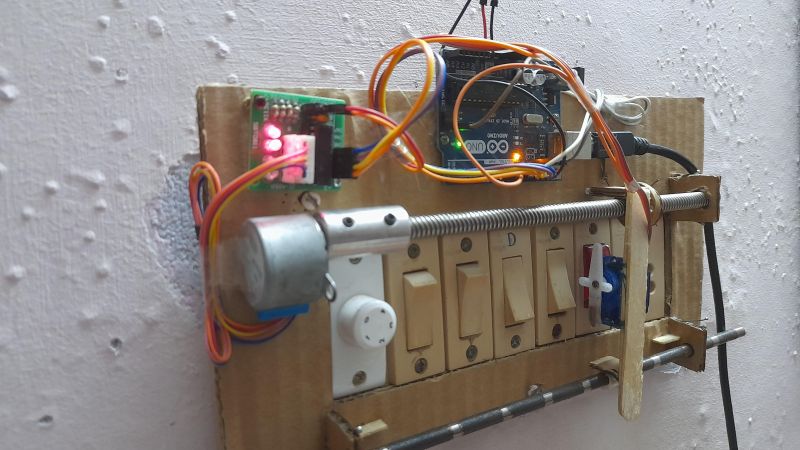At Hackaday, we celebrate all kinds of projects, but we’ll have to admit that the polished and professional-looking builds tend to catch our eye a lot more than perhaps they should. There’s plenty of love to be had for the rougher builds, though, of which this quick-and-dirty home automation system is a perfect example.
Before anyone rushes to state the obvious with, “Should have used some relays,” consider that [MAKE_IT_WITH_ME]’s stated goal was to get the basics of a home automation system built with pretty much nothing but what can be found in one of those Arduino starter kits. And further, consider that landlords might not look kindly on tenants who wire a bunch of SSRs or Sonoff switches into the walls of their building. So this minimalist build is perfect for certain use cases. Its interface to the building’s electrical system is 100% mechanical, via a servo that travels along the bank of switches on a stepper-driven leadscrew. The servo has a modified horn to properly flick the rocker-style switches, and although changing from switch to switch is a bit slow, it works surprisingly well. The video below shows it in action.
While we can see it possibly working as-is for Decora-style switches that are seen in some markets, we’d think some mods would be in order for the more standard toggle-style switch — perhaps a finger extending out from the horn, along with a second servo to tilt the whole assembly away from the wall to allow it to clear the switch bats.
















Take your time. No rush.
I like amateur builds. This isn’t really too practical, but it might be an idea that can be used for another type of project, maybe the start of a plotter, or some robot arm etc.
I built something similar a while ago: https://youtu.be/rsfD2FmUwCQ
And I really liked it. No need to mess around with high voltage, no risk of setting the house on fire, no need to be confronted by your landlord and most importantly: The switch still works as before. I could choose between automation and old school usage and even if the automation is broken I can still turn on my lights.
No relays were harmed during the execution of this project :)
I do like the home-switch made out of two pieces of wire, and that he made the back plate out of a piece of cardboard.
I hope it’s the cardboard of the arduino starter kit…
Te trapezium allthread and coupling are more 3D printer parts. Are those in arduino starter kits?
Still a good opportunity to have some fun.
Should have been a 555 lol
The base is even card board paper. I love that. Sprinkle some water on it and it will fell down in pieces. LOL.
Your light switches see a lot of water?
Yes, when I clean the switches and wall.
I did that … once … pushed out a cleaning sponge over an old, tornup 3-phase “high” voltage outlet … had a second to think “oh sh*t” and jump back before the spark, the ozone and the trip to the basement to reset the breakers.
All it need is a hamster, and it could be straight out of a Terry Gilliam movie.
Very creative. How switch mains voltage without messing with mains voltage, 10/10
It’s called a relay.
A relay doesn’t magically cause connections to happen, you still have to wire the mains through one side.
I think this is great on a number of levels. First, it works. Second, it was made with things on hand. Third, it was attempted by someone who was learning things, not by someone simply exercising previously possessed knowledge.
Anytime someone pushes against the boundary of what they know and wins, it is success. [MAKE_IT_WITH_ME] gets today’s McGyver award, imho.
Only practical flaw AI see is it should move the servo out of range when not operating ie not blocking any existing switch, this would allow easy manual operation as well. Home automation should not remove the ability to walk up to device/panel and operate it conventionally
This is a super cute build.
Ever hear of Switchbots ??? 😂👍🏼✌🏼
GREAT!
Might need some work on the WAF side.
How to make a useless machine useful?
https://www.youtube.com/watch?v=Nqk_nWAjBus
Used something like this 1978 to program our first computer gaging unit [ used an RCA 1803 CPU with a 4K memory chip [ actually used only 1850 bits ] [ was in MPB – Keene, NH Starting Torque tester ]
Rube Goldberg would approve…
How exactly do you use a relay to control mains voltage without messing with the mains voltage wiring?
my comment was a reply to gsmi
Now you can make the old saying “He’s so fast he can turn the lights off and be in bed before it’s dark!” a reality. But as others have pointed out this turns the lights on and off and you don’t have to play with high voltage, which amateurs fear and landlords hate, good job.
This is definitely a DIY solution for Australians. Apparently it’s illegal to even change a light switch there unless you’re a licensed electrician there.